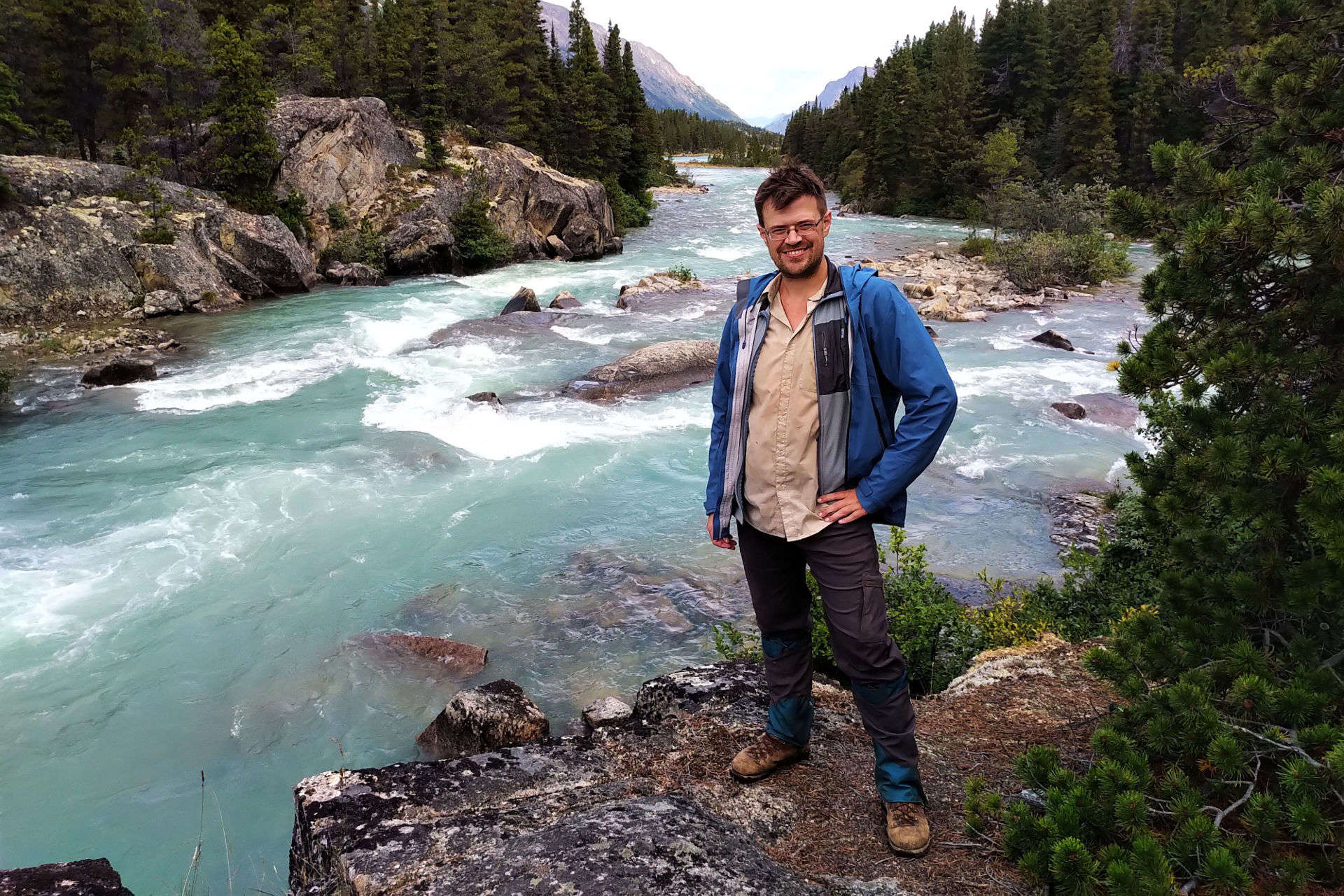Bears are smarter than many people, and stronger than most. This past August another Problematic Bear at Garibaldi Provincial Park learned the knack of shimmying up BC Parks’ official bear hangs and bringing the bags down. Several hikers lost whole backpacks until conservation officers shot the bear.
This is the second-best recent British Columbia “bear defeating bear-proofing” story. The winner was at Akamina Creek in 2021, where a bear was caught non-chalantly opening bear-proof lockers right in front of several hikers (private video on the Great Divide Trail Hikers Facebook group). A few years ago Andrew Skurka shared a spreadsheet on Yosemite bears getting food from the portable hard-sided bear canisters. Most incidents involve user stupidity, but far from all. Given time, a cliff, a manufacturing defect, a slight fault in procedure, a plastic container weakened by UV, or just one that’s smarter than the av-er-age bear, that food is gone.
Traditionally this is when the author brags that he does it right. My food is all dehydrated meals and packaged snack bars, kept in an OPSAK resealable odour-proof bag that’s in turn tied inside an Ursack, hung on or stored in permanent infrastructure whenever available. Sure enough, a bear has never eaten my food (raccoons ate some once).
Except OPSAKs pick up odours from handling even before the openings fail, which they always do. Ursacks can be defeated when overfull, tied improperly, or a bear has four hours to work on the thing.
The author of this post is neither a bear expert nor highly experienced. In the wild he does what seems like it ought to work well enough. However, like most people who’ve lived in the world the past few years, he has a well-developed contempt for the narcissism of the expert. Responding to the Garibaldi incidents, the CBC quoted unnamed “advocates” whose words had no relevance to a bear climbing up the bear hang. Whenever a bear gets away with someone’s food wiseacres say “he probably didn’t do it right” and insist that if you follow these fourteen weird tips faultlessly every time you’re sure to be safe. It amounts to endlessly trusting the plan.
Incidents of bears taking food from backpackers are rare; rarer than one might think and in general rarer than they used to be. Hard data aren’t always publicly accessible, but the Yosemite spreadsheet I linked above recorded 184 interactions between bears and hiker-carried bear attractants (food, garbage, toiletries) over four years. No doubt many incidents go unreported but given that Yosemite is home to one of the world’s bravest populations of black bears and a vast number of hikers, that’s not a large number. There are more interactions than that between black bears and garbage cans in Metro Vancouver.
Yellowstone National Park, which spawned a cartoon about grizzlies stealing pic-i-nick baskets, claims to have reduced negative bear-human interactions 90% in a couple generations, essentially, by trying.
So the point is not that there’s nothing we can do. Quite the contrary. A hiker does not need to make his food absolutely bear-proof, he just has to make it more of a pain in the ass to the bear than finding berries or salmon. The bar here is not super high, until the bear is desperate; then it is suddenly enormous.
The adoption of bear strategies has helped, shooting problem bears has helped, the widespread switch from cooking in the backcountry to relatively low-odour and low-waste dehydrated meals has helped. But with such a small number of interactions it’s impossible to say which factors are most important. Ursacks and the classic blue plastic BearVault are defeated relatively often, but they are also by far the most common bear containers on the trail. The carbon fibre Bearikade canister claims “over 22 years of field service without loss of food to any wild animal”; they are also rare on account of starting at US$300. Every bear container, hard-sided and soft, approved by any park today has survived the “have the manufacturer load it perfectly, then throw it into a cage with a hungry grizzly and let him have a go” test.
It’s not that “bear protection doesn’t work,” but the old slogan is still best: be bear-aware. As with literally everything in life, don’t blindly trust a system. Pay attention to your environment. If you aren’t sleeping with your food, don’t put it so close that a bear will have to be only slightly brave to sniffle around your tent; but don’t put your food so far away that the bear can get to it unattended in the night. If you’re in a Yosemite, or a Yellowstone, or one of those other big-league parks where both hikers and hungry, bold bears tend to congregate, know that. If you’re on a trail that sees less than a hiker a day, know that too.
Don’t just trust in a routine you read about online or learned from an experienced friend that’s “worked so far.” Remember how rare incidents are. Bear defenses are seldom tested, most pepper spray goes in the trash unfired, most Ursacks are abused by nothing more than dirt and rocks, most hangs really just need to be mouseproof.
However you’re dealing with your food, deal with it in a way that you can actually execute. A hard-sided bear canister is probably safer than an Ursack1, but if you have nine days of food and your canister holds seven so you put the other two in a dry sack, your defenses are reduced to the level of a dry sack for two days. The bear canister you can’t bring because it’s too bulky is useless, the carbon fibre aerospace-engineered bomb-proof bin you can’t afford is useless. The bear hang you can’t make bear-proof is one shade better than useless, and that’s almost all of them because bear hangs are stupid-difficult and so rarely tested that it’s impossible to improve by trial and error2. Andrew Skurka, who is paid cash money to go hiking in bear country and has spent more nights doing it than you and I put together, prefers sleeping with his food to hanging it in sites where the chances of a bear encounter are remote. Some of his posts provoked incandescent rage from people who compared this simple approach to the theoretical bear hangs that exist only in their minds.
I’m sorry to burst the stupid bubble this folks have going on, but if you’re risk tolerance includes the words “only really desperate bears would be a problem”, you need to stop giving people advice and completely rethink your strategy. The whole idea is to prevent, to the greatest degree of plausibility, your food being the thing that baits a “really desperate bear” towards you or your campsite.
This is some of the dumbest shit I’ve ever seen in my life. It’s crazy to me that someone so experienced would advocate for such risk-taking not just to those willing to listen to him in person, but to do so on a blog on the internet.
“There’s little (or no?) data to support that assumption, but it seems intuitive.”
Are you serious right? You literally pulled this out of your ass dude.
“Depending on the local risks and your risk tolerance, you may also consider sleeping with your food. This is widely practiced, but few are willing to talk about it.”
Cigarettes are widely-practiced, but that doesn’t make them a good idea for your health.
“In this post I’ll explain my approach, but I’m not recommending that you do the same, nor can I guarantee that you’ll have the same results.”
This is nonesense dude. You absolutely are recommending this to people. That’s the whole point of the original post, as well as this follow-up post doubling-down on the idea and detailing it further. YOU ARE RECOMMENDING IT, regardless of your assertion otherwise.
You should take down this page, and for your own sake, you should stop making this unnecessarily risky decisions when there are much safer preventative measures.
This is extremely frustrating material to read. I came here expecting to be educated by someone with great experience. Instead I got a hard-headed cook who’s wantonly taken the initiative to put others in danger by propagating his none-sense risk-forward mentality to other people.
…or…
A professional should not be giving out this sort of advice. Beginners and amateurs and pompous idiots will read it and take it as sound advice because he is “an experienced professional”. Well, I too am an experienced outdoor professional, book author and seasoned outdoorsman, even applied for a job position working for Andrew and this advice is ludicrous! Andrew and any experienced hiker that think like him are playing Russian roulette and they are handing the weapon to novices after adding more rounds. I have had 3 bear encounters, 2 yote encounters, countless rodent encounters and a couple monkey encounters related to food. Fortunately the only ones that got away with food were the monkeys. This advice is foolish and borderline criminal. Andrew, you should be ashamed of yourself for publishing this information to the masses, honesty or not. You should be stripped of all merit and anybody that sponsors you should seriously consider removing their brand from your name before bear attacks are linked to your horrible advice. You would be wise to take these articles down.
I will even link to who I am because I am that confident in how bad this advice is. I don’t care how lucky you have been thus far, its only a matter of time before someone dies because of this article. So very disappointed in this “professional”Oh and….no financial affiliations …… I receive a small commission from select vendors. You do realize these two statements contradict themselves in their entirety… right?
I promise, I didn’t cherry-pick the insane people. We’ve all been obliged in the past two years to get very well-acquainted with this view of “safety,” where effort and misery are moral imperatives regardless of what they actually help: societal narcissism, the attitude that nature will submit to us if we believe hard enough and make everyone else believe too.
When I was at La Grace campground on the South Boundary Trail, somebody had tied a couple bags to the hang with the Pacific Crest Trail method, where you use a clove hitch, a twig, and a carabiner to secure your food. I know they did, because I saw their cords hanging, cut off, where the delicate knot required for the PCT method had failed and they’d been unable to retrieve their food otherwise. “Well,” says the hang advocate, “he didn’t execute the system perfectly.” Quite. I daresay a hiker throwing PCT hangs with high-end cord on the South Boundary Trail was not on his first rodeo, either.
Bear canisters suck. They’re bulky and awkward, they don’t hold enough food, they need a tool to open and you better not lose or break yours. Ursacks suck in different ways; they’re a pain to tie properly, oh-so-very tempting to overfill, and even when a bear can’t get in he might well make your food inedible with his noxious spit. All bear canisters are expensive, except for free or cheap rentals and loaners available at some parks, but those are well-used and vulnerable to all the foibles of equipment that’s a bit worn out. Whatever solution you use, if it’s the evening and you go get a snack, then put the trash away, then later make dinner, then later have tea, you need to resist the temptation to leave anything lying around between those pleasant tasks rather than perfectly sealing and securing your cache, which isn’t always straightforward when you’re tired, it’s a few days in, everything seems quiet, and you’ve gotten away with it the last hundred times.
Sometimes, in nature, bad things will happen. You’ll do the best you can and still get hurt. The best mountaineers tend to die on mountains. Nature is stronger than any of us and accepting this, while not becoming uselessly fatalistic, is part of the path to wisdom.
In today’s Canadian Rockies more people are killed by the trees than the bears3. This should inform your paranoia. Go up to Denali National Park in Alaska, which this summer I just might, and forward mama grizzlies are rather more common. Pay attention to that too. At all times, trust the skills you can develop and prove, rather than theoretical perfection. Above all, be humble.
- I base this off instinct and reading, not the data, which do not adequately exist and never will. If we could know that a Bearikade left out overnight was unharmed 99.995% of the time, a BearVault 99.99%, an Ursack tied to a tree trunk 99%, and throwing your food in a grocery bag on the ground worked out 80% of the time at a given site, we’d be getting somewhere, but we can’t.
- I’m going to put the point that bear hangs are borderline impossible into a footnote. In order to defeat a bear by hanging alone, the hang must a) hang a food high enough that a bear can’t reach it from the ground, b) suspend it far enough from any trees that a bear can’t climb to it, or climb to a point where he can jump on it, and c) also keep the rope itself safe from a bear, without making it inaccessible to the hiker. At most campsites this literally cannot be done: the Goldilocks trees with plenty of height, plenty of space between them, and no treacherous bear-encouraging interloping limbs that let you achieve all this simply don’t exist. Even where it’s physically possible, the skill required to get it just right is diabolical. And, most treacherously of all, if you’re doing it wrong you’ll never know until one day the bear comes and tries it out. Most of the time we try something, it doesn’t quite work, we do it better next time, and develop our skills. A half-useless bear hang and a perfect one will feel the same to the hanger 999 times out of 1000. You won’t even know you’re doing it wrong until you hear the bear go smack into the ground with your food at 3 AM after doing a kamikaze dive onto the bag from the third-nearest pine tree. It’s true that even a moderately-shitty hang will deter the average bear better than leaving your food on the ground. So will leaving it in your tent under your feet while you sleep. A bear has to be a lot braver to attack you than to attack your shitty hang. There are exceptions; if you’re a professional hunter who has to cache deer carcasses sixty nights a year every fall, you probably learn the difference between 60% and 95% effectiveness pretty quick. But they’re rare.
- This is not a blithe remark for literary effect. It is literally true.




If you do go to Denali NP – I recommend looking into the Discovery hikes. I did one years ago when I was up there and they take you off trail for the day in a part of the park where they haven’t done a discovery hike in years. It was neat, but it is a group that goes not a large one, but a group none the less.
I actually had been looking at those. They’re the sort of thing that’s not usually for me but when I read up on them I found myself surprisingly interested, so thanks for the recommendation.
Thanks for writing the report on your trip on the South Boundary Trail. It contains the sort of detailed, practical, and current information which is hard to find. I spoke to a warden in Jasper NP’s backcountry office, and he wasn’t able to give me even a fraction of the information about the current state of the the trail and campsites.
One question – Did you gather any information about the trail to Southesk Lake which branches off the SBT near the Cairn River Campsite? The Jasper warden was only able to confirm the existence of this trail and the two campsites along it (Dean Pass Campsite and Southesk Lake Campsite). I ask because I would like to backpack to Southesk Lake in late-summer 2023, starting and ending at the Nigel trailhead on the Icefields Parkway.
Glad it helped!
I didn’t look up the trail to Southesk Lake myself, beyond seeing that the trail junction was there and signed (though it’s in the middle of the Cairn River washouts so make sure you keep the trail). I did talk to some people who had just finished a Southesk Loop trip that went through there and they described it as wet, with many fords, and brushy, but they got through and thought the portions of the loop after Southesk Lake were worse. Afraid I don’t have any first-hand information, though.
Those pieces of information about the Southesk Lake route are helpful.
Thanks again for publishing so much information useful to backpackers, and for writing it up in such an entertaining way.